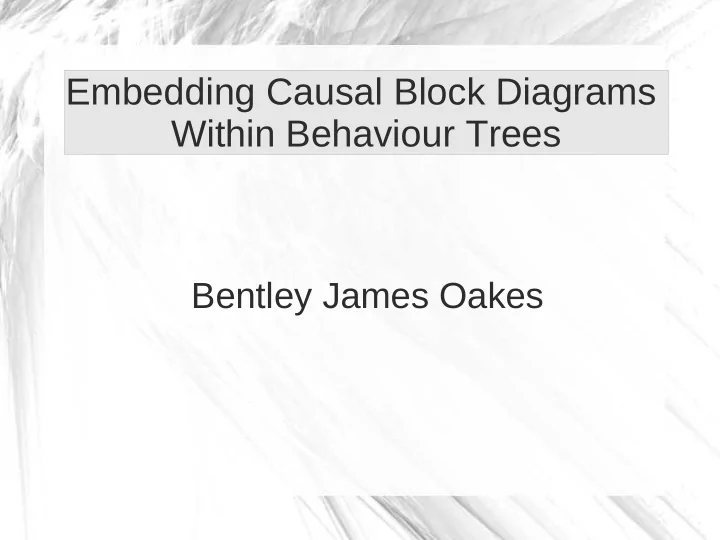

Embedding Causal Block Diagrams Within Behaviour Trees Bentley James Oakes
Outline Problem to Address Proposal Formalisms Used Experiments Results Future Work Conclusion
Causal Block Diagrams Blocks compute values at each time step Outputs connected to inputs
Problem =========== Signals Dumping Begin =========== multiply0 Product [0.1, -0.0, -0.011, -0.022, -0.032, -0.043] secondmultiply Product [0.0, 0.11, 0.110, 0.108, 0.106, 0.103] delay0 Delay [1.0, -0.0, -0.11, -0.22, -0.328, -0.435, -0.539] =========== Signals Dumping End =========== How do we visualize/connect to simulation?
Proposal Find formalism to embed causal blocks into Criteria: Equivalent One-to-one representation? Increase in power? Easily understood/changed Easy to visualize (model/simulation)
Behaviour Trees Each agent in a simulation has a tree Query tree to determine action of agent Starting at root node: Each node will: Query children Perform action Return true/false
Behaviour Tree Example
BT Advantages Easy to construct/rearrange trees Used in video games: Halo 2/Spore Trees can control animation/sounds/AI Merge calculations with higher-level control Lazy evaluation Don't solve everything at once
Similarities to CBD Both have nice tree structure Modular design Combine nodes for any function Values are passed up tree Exploration of a formal equivalance CBD → Behaviour tree Behaviour tree → CBD
Differences Algebraic loops in behaviour tree? Special handling required Not implemented in project Only true/false value passed up Easily fixed → change to float 0 is false, anything else is true
Embedding CBD blocks map onto BH nodes directly ● Adder ● Multiplier ● Inverter ● Negator ● Constant ● Test ● Delay ● Integrator/Derivative*
Sample Embedding
Embedding Multiplier node update(): If children.size == 0 output = 0 Result = 1 For Child c in children Result *= c.update() Output = result
Experiments Circle Test: Use integrators to draw x(t) vs dx/dt(t) Personal Space: Many agents in world One agent walks from start to goal All agents move away from each other
Results – Circle Test
Results – Circle Test
Results – Personal Space
Results – Personal Space
Future Work Detect algebraic loops Implement behaviour trees in Atom3 Add detail to model visualization Explore formal equivalence
Conclusion Behaviour trees add lots of power Control flow Handle animation/events Superset of CBD? Visualization needed Evolution of values Hook into simulation
References Clark Verbrugge. COMP 521 course notes. 2012. Hans Vangheluwe. COMP 522 course notes. 2012. Damian Isla. Managing complexity in the Halo 2 AI system. In Proceedings of the Game Developers Conference, 2005. Chong-U Lim. An A.I. Player for DEFCON: An Evolutionary Approach Using Behavior Trees. Imperial College, London. Questions?
Recommend
More recommend